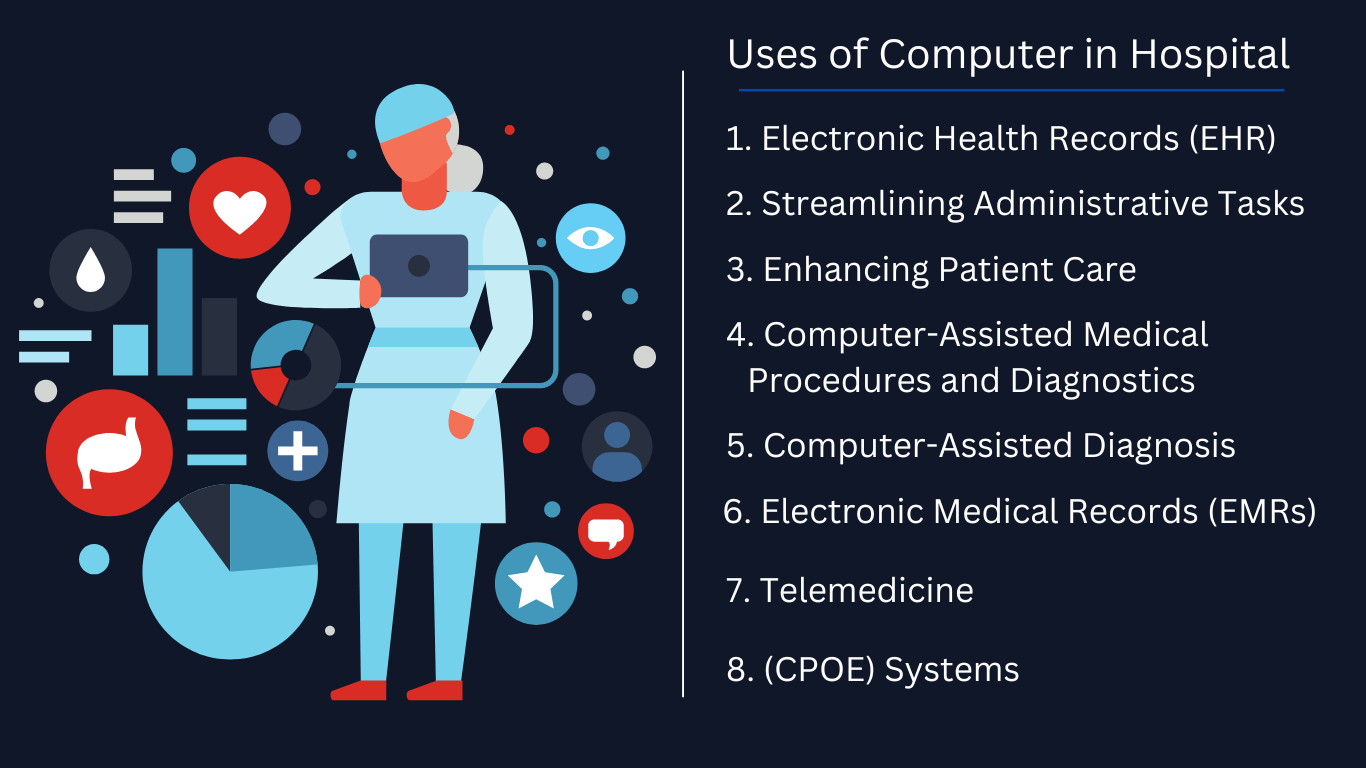Uses of Computer in Hospital: In today’s rapidly evolving healthcare landscape, the integration of technology has become vital to delivering efficient and effective patient care. Computers have revolutionized the way hospitals operate, providing a wide range of benefits that have transformed the healthcare industry.
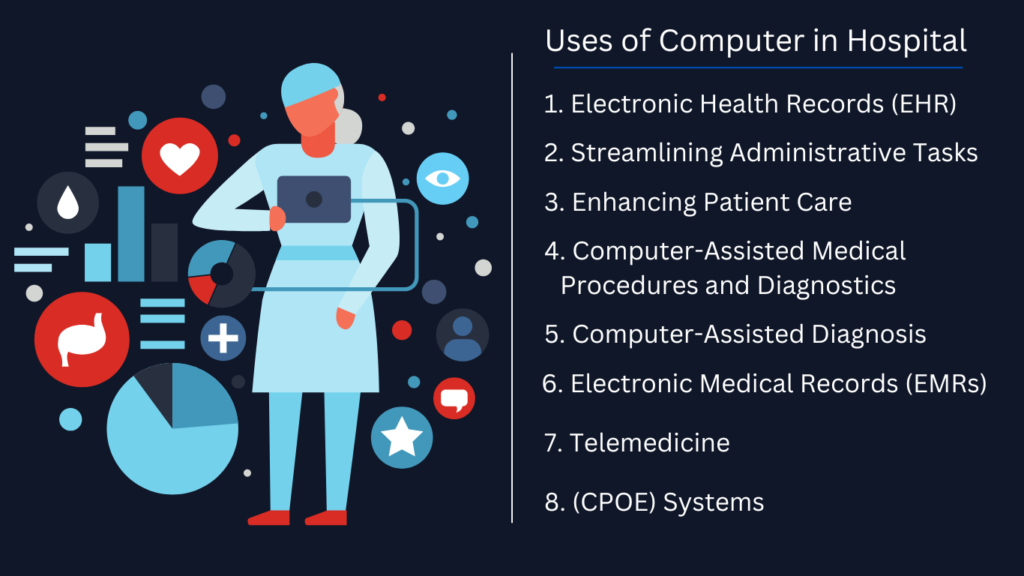
In this article, we will explore the essential ways in which uses of computer in hospital and the impact they have on the delivery of healthcare.
Computer uses in Hospital | Uses of Computer Hospital
1. Electronic Health Records (EHR) and Patient Management
Electronic Health Records (EHR) is One of the most significant uses of computer in hospital. These computerized systems allow healthcare professionals to access patient information instantaneously, improving the accuracy and efficiency of diagnoses and treatments. With EHR systems, all relevant patient data, such as medical history, medications, and test results, are stored in a centralized electronic database.
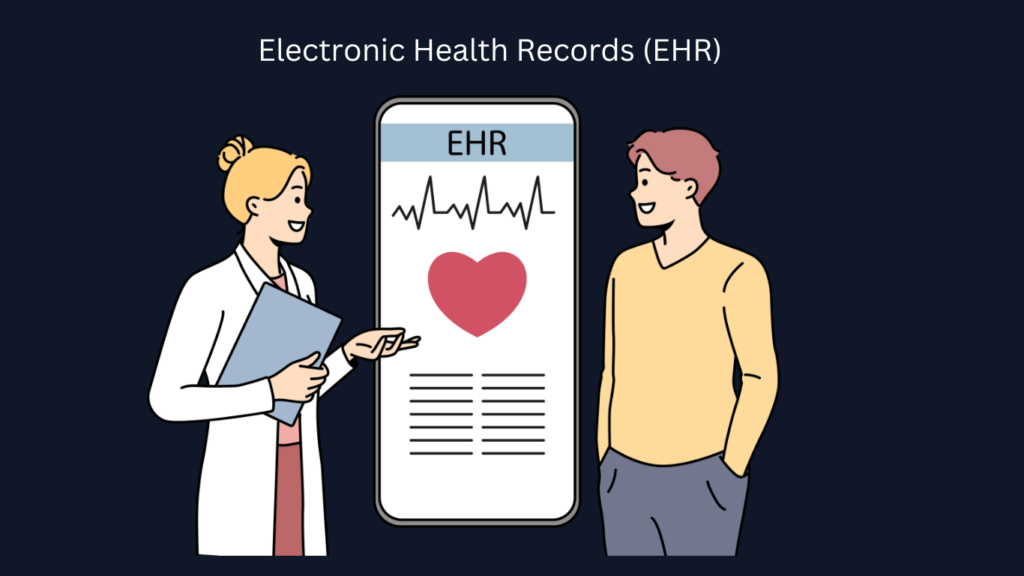
With the help, of Computer EHRs enhance patient safety by reducing the risk of medical errors. Computerized systems provide alerts and reminders for potential drug interactions or allergies, minimizing the likelihood of adverse events.
2. Streamlining Administrative Tasks with Computer Systems
With the help of computer systems can computerized appointment scheduling systems eliminate the need for manual record-keeping, reducing the risk of double bookings and improving overall patient flow. These systems also enable patients to book appointments online, providing them with convenience and flexibility.
By streamlining administrative tasks, computers have freed up valuable time and resources in hospitals. This has enabled healthcare professionals to allocate more time to patient care, leading to improved overall efficiency and satisfaction.
3. Enhancing Patient Care through Computerized Medical Devices
With the help of computerized medical devices have transformed the way patient care is delivered in hospitals. These devices are designed to monitor and assist patients, providing real-time data that can be used to make informed clinical decisions.
One of the most widely used computerized medical devices is the vital signs monitor. These devices continuously measure and record a patient’s vital signs, such as heart rate, blood pressure, and oxygen saturation. The data collected by these monitors is instantly transmitted to the healthcare team, allowing for early detection of any abnormalities or deterioration in a patient’s condition.
4. Computer-Assisted Medical Procedures and Diagnostics
Computer-assisted procedures and diagnostics have improved accuracy, reduced invasiveness, and enhanced patient outcomes. Computers have had a profound impact on medical procedures and diagnostics, revolutionizing the way healthcare professionals perform complex tasks.
One area where computers have made significant advancements is in surgical procedures. Computer-assisted surgery involves the use of robotic systems or computer guidance to assist surgeons in performing complex procedures with greater precision. These systems provide real-time imaging and feedback, allowing surgeons to make precise incisions and reduce the risk of complications.
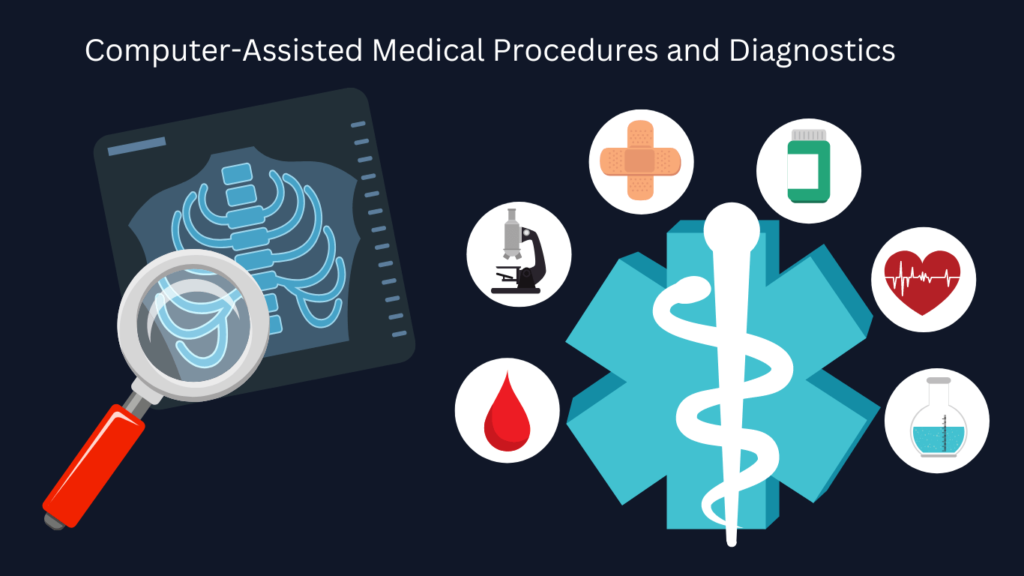
The integration of computers into medical procedures and diagnostics has revolutionized healthcare, allowing for greater precision, accuracy, and improved patient outcomes. These advancements have transformed the way healthcare professionals approach complex tasks, leading to safer and more effective treatments.
5. Computer-Assisted Diagnosis and Treatment
Computer-assisted diagnosis and treatment have become essential tools in healthcare, aiding healthcare professionals in making accurate and timely decisions. These systems utilize artificial intelligence and machine learning algorithms to analyze vast amounts of patient data and provide evidence-based recommendations.
Computer-assisted diagnosis systems analyze patient symptoms, medical history, and test results to generate potential diagnoses. These systems can quickly process large amounts of data and compare it to vast medical databases to identify patterns and potential diagnoses.
Computer-assisted treatment systems utilize algorithms to analyze patient data and provide treatment recommendations based on evidence-based guidelines. These systems can consider various factors, such as patient demographics, medical history, and medication interactions, to provide personalized treatment plans.
6. Electronic Medical Records (EMRs)
In addition to electronic health records (EHRs), electronic medical records (EMRs) play a crucial role in transforming healthcare delivery. EMRs focus on the individual patient and contain detailed information about their medical history, including diagnoses, treatments, and laboratory results.
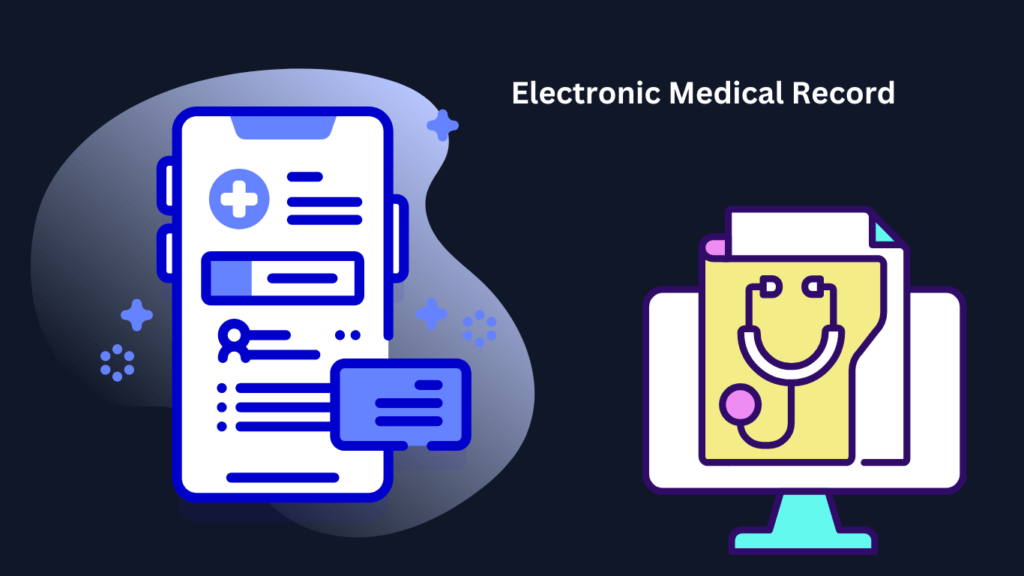
EMRs also facilitate the sharing of patient information among healthcare providers, leading to improved coordination of care. With electronic records, healthcare professionals can quickly and securely share patient information, reducing the risk of miscommunication and ensuring seamless transitions of care.
7. Telemedicine and Its Impact on Healthcare Delivery
Telemedicine utilizes computers and telecommunications technology to provide remote clinical services, including consultations, diagnoses, and treatment. Telemedicine has revolutionized the delivery of healthcare, particularly in remote or underserved areas.
Telemedicine also improves the efficiency of healthcare delivery by reducing the need for in-person visits. Patients can consult with healthcare professionals through video conferencing or secure messaging platforms, saving time and reducing healthcare costs.
8. Computerized Physician Order Entry (CPOE) Systems
Computerized Physician Order Entry (CPOE) systems have revolutionized the way healthcare professionals order medications, tests, and procedures. These systems eliminate the need for paper-based order forms, reducing the risk of errors and delays in patient care.
CPOE systems also improve the efficiency of order processing, leading to faster turnaround times and reduced waiting periods for patients. Orders can be processed electronically, eliminating the need for physical transportation of order forms or prescriptions. This streamlines the workflow and ensures that patients receive timely and appropriate care.
The implementation of CPOE systems has transformed the way healthcare professionals order medications, tests, and procedures. These systems have improved the accuracy, efficiency, and safety of patient care, resulting in better outcomes and higher patient satisfaction.
9. Improving Communication and Collaboration among Healthcare Professionals
Computers have played a crucial role in improving these aspects of healthcare delivery, enabling seamless communication and collaboration among healthcare teams. Effective communication and collaboration among healthcare professionals are vital for delivering high-quality patient care.

Computerized communication systems, such as secure messaging platforms and electronic referral systems, have replaced traditional paper-based methods. These systems allow for instant communication between healthcare professionals, regardless of their physical location.
The use of computers in communication and collaboration has also extended beyond healthcare professionals. Patients can now access secure online portals to communicate with their healthcare providers, request prescription refills, and access their medical records.

